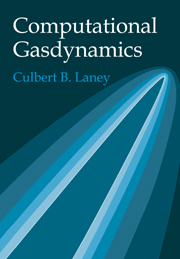Book contents
- Frontmatter
- Contents
- Preface
- Chapter 1 Introduction
- Part I Gasdynamics Review
- Part II Computational Review
- Part III Basic Principles of Computational Gasdynamics
- Part IV Basic Methods of Computational Gasdynamics
- Chapter 17 Basic Numerical Methods for Scalar Conservation Laws
- Chapter 18 Basic Numerical Methods for the Euler Equations
- Chapter 19 Boundary Treatments
- Part V Advanced Methods of Computational Gasdynamics
- Index
Chapter 19 - Boundary Treatments
Published online by Cambridge University Press: 07 December 2009
- Frontmatter
- Contents
- Preface
- Chapter 1 Introduction
- Part I Gasdynamics Review
- Part II Computational Review
- Part III Basic Principles of Computational Gasdynamics
- Part IV Basic Methods of Computational Gasdynamics
- Chapter 17 Basic Numerical Methods for Scalar Conservation Laws
- Chapter 18 Basic Numerical Methods for the Euler Equations
- Chapter 19 Boundary Treatments
- Part V Advanced Methods of Computational Gasdynamics
- Index
Summary
Introduction
This chapter concerns boundary treatments. Before now, the book has avoided boundary treatments by using either infinite boundaries or periodic boundaries, but one cannot remain innocent forever. Boundary conditions and governing equations have equal importance, despite the fact that most sources, including this one, spend most of their time focused on the governing equations. For the same governing equations, boundary conditions distinguish flow over a plane from flow over a train from flow over a space shuttle from any other sort of flow. In practice, numerical boundary treatments often consume a large percentage of computational gasdynamics codes, both in terms of the number of lines of code and in terms of the development effort.
This chapter concerns two types of boundaries – solid and far-field boundaries. Solid boundaries are also known as surface, wall, rigid, or impermeable boundaries; naturally enough, solid boundaries occur at the surfaces of solid objects. This chapter considers only stationary solid boundaries. Far-field boundaries are also known as open, artificial, permeable, or remote boundaries. Far-field boundaries limit the computational domain to a reasonable finite size; the true boundaries may be extremely far away, or even infinitely far away, at least conceptually. In general, when the physical domain is very large or infinite, then the farther away the numerical far-field boundary is, the more accurate but also the more costly the numerical approximation will be. Far-field boundaries are divided into inflow boundaries, where fluid enters the computational domain, and outflow boundaries, where fluid exits the computational domain. In multidimensions, far-field boundaries may also be streamlines, across which fluid neither exits nor enters.
- Type
- Chapter
- Information
- Computational Gasdynamics , pp. 430 - 454Publisher: Cambridge University PressPrint publication year: 1998



